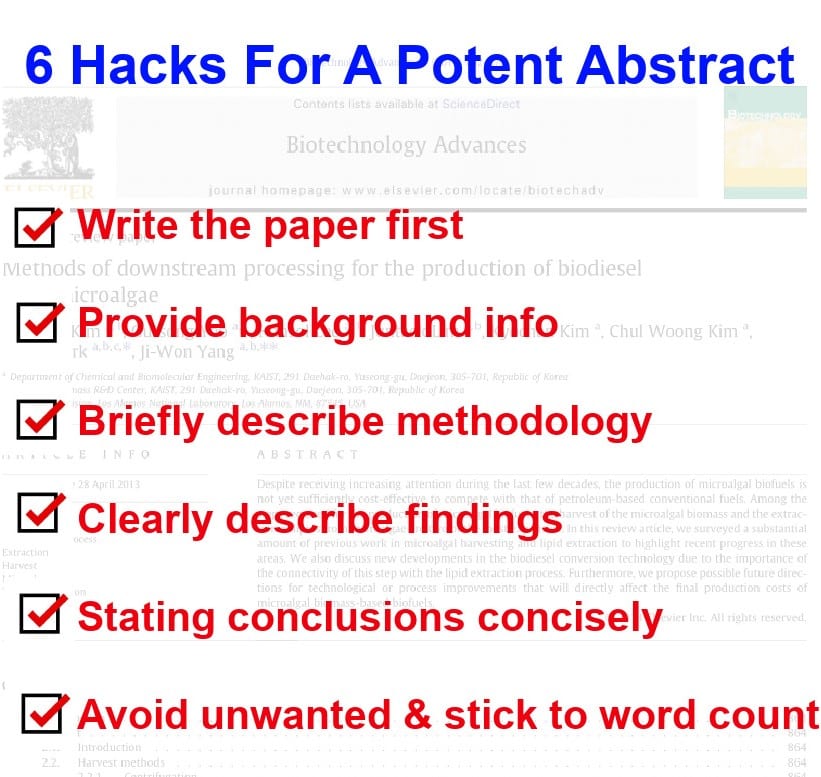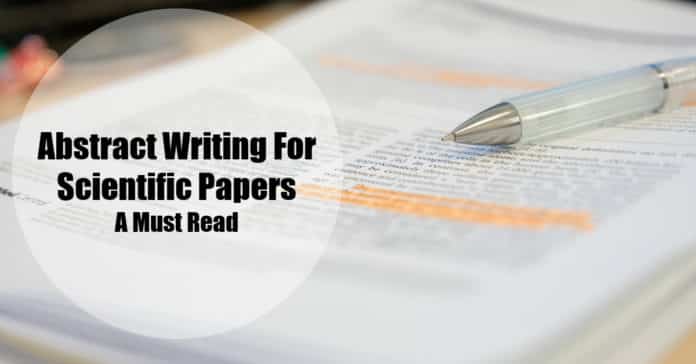Abstract Writing For Scientific Papers – A Must Read
An abstract is the core element of a scientific manuscript that sets the tone for the entire content. Abstracts are potent tools to grab the attention of the target audience. Besides imparting a holistic perspective of the research project, integrating appealing disclosure and meaningful reports can escalate the expectation levels in the targeted people. Usually an abstract delineates the subject that one intends to disclose, pinpointing the contribution, evidence, and arguments.
Abstracts are the only carefully read portion of scientific manuscripts, especially by the reviewing committee and readers. Likewise, this is the only part reported in conference presentations. Readers commonly look at the title and if the title is found interesting, they jump to the abstract rather than perusing the entire content of the manuscript. Keen readers and those having a particular interest will continue reading the whole paper. Therefore, for a large group of people, scientific manuscripts don’t exist beyond the abstract. Hence, authors have the responsibility to assure that abstract is perfectly representing the whole paper.
This synopsis is typically confined to around 250 to 500 words. It is a common misconception that short and explicit abstract writing for scientific papers is challenging. It is a piece of cake if you comply with the fundamental guidelines and evade common mistakes enlisted in this article.
Significance Of An Abstract In A Research Manuscript
Two key roles of an abstract in a scientific paper are:
- Selection – Since abstracts are short and crispy nutshells of research papers, it helps readers to quickly decide. A clear, direct, and riveting tone must be present in an abstract for more readers
- Indexation – Currently there are millions of research papers available online. To rank (index) these, databases employ abstracts of scientific papers. Appropriate addition of keywords and a well-composed abstract can improve the paper quality.
Parts Of An Abstract
Even though few journals still approve abstracts that are drafted as mixed-up paragraphs, most of them demand a specific format with the mentioned word limit. The common sections in an abstract are Introduction (Background), Methods, Findings (Results), and Conclusions. Few journals also have parts like Limitation and Objectives. Let us go through each section to give a detailed understanding of what to be written from each part for an abstract.

I. Background
This part is the smallest section of an abstract and must very shortly summarize the following details:
- Already known information on the topic
- Unknown information on the topic and objectives of the study
Background can mostly be structured in just 2 to 3 sentences with each elucidating a distinct facet of the subject. The aim of the background is to offer a framework of the study and a smooth transition to the next content of the paper. Try to make the background short or else the results part, the reader-favored section, will be inadequate.
II. Methods
In an abstract, the method section is mostly the second-biggest part. It must comprise necessary details to facilitate a thorough understanding of the study, answering both how and what. Negligently drafted methods will not have enough details on crucial aspects. Readers can easily find out this pitfall. Therefore, this part has to be scrupulously composed.
III. Results
This is the biggest and most significant part of an abstract as all readers seek the findings of the paper while perusing. Try to include as much information as possible with the world limitation for this section.
IV. Conclusions
The final part of the abstract has the most vital take-home message of the work, conveyed in a concise and specific way. It is a common practice, not mandatory, for the writers to convey the inferences or relevance of their results for the particular field in conclusion.

Regardless of its compact structure, this part has the greatest effect on an ordinary reader since they usually trust writers and believe their statements as such. Therefore, the conclusion part has to be honest.
Tips For Drafting A Good Abstract For A Research Paper
Make It Concise & Clear
Usually, abstracts don’t exceed 250-300 words. Seize the absolute essence of the study and sprinkle some magic of excitement and curiosity with it. Utilize active voice and make sure to avoid too much prepositional phrasing.
Making a rough draft before the actual is a good practice. An ideal abstract will have these key points:
- The persisting problem for which the study is conducted
- Proposal for addressing the problem
- Proof
- Current updates in the field and how this study contributes
- The relevance of this study to others
Abstracts should be crisp and without any overreaching assertions. Add what you require and nothing more. Always, Always keep your target audience in mind!
Make It Standalone Worthy
Abstract has to speak for the entire study completed which can govern the importance of the research work. The structured abstract with the inclusion of key points from each and every part of the scientific paper is absolutely necessary.
Make Use Of A Proper Format
Using a fundamental yet productive format will assist in keeping a properly organized abstract. This will also help in easy gliding through the contents. Check the guidelines of the journal prior to drafting.
Make Sure To Comply
Carefully adhere to all the rules and standards for an abstract provided by the journal. Cross-check whether all the points are verified in the paper prior to submission. If at all, there are no specific guidelines for abstract writing, make it short because review committees don’t prefer lengthy abstracts.
Make Sure It Is Clean
Re-check and modify the abstract to assure that the final draft is error-free. This processing phase is the ideal time to extensively go through the wordings and trim whenever needed. Request a second person to read your abstract to verify its clarity. It must be an unbiased and smooth summary of the research work.

Common Mistakes To Avoid While Drafting An Abstract

Try restricting to one relevant question because the more questions, the more space you consume for answering them, and no room for other significant matters. Also, make sure to address the question if you pose one.

Always stay on the simple tone and eliminate unwanted details. Since the main focus is to capture the reader’s attention, who is reading many articles at a time, it is good to avoid unnecessary matters.

Claims are repeated unknowingly most of the time. This can also happen when the author is not clear about the argument. Ponder on it a bit more and then compose. Sometimes this could be due to lack of proofreading and careless writing. Bear in mind to keep each sentence distinctive and that it enables a flawless and smooth read.

The person reading the abstract is not looking for the entire story of the study. Providing the gist clearly is enough for an abstract.
How To Read Scientific Papers?-Check Out At Biotecnika
Most of the journals mention the rules to be followed for writing a scientific paper. These guidelines will often explain abstract writing for scientific papers. Writers must modify their abstracts to the required standard of the desired journal. It would be great if one can model an abstract from a previously approved parallel paper from the same journal for getting a clear picture of how it is structured and composed.
Abstract Writing For Scientific Papers






